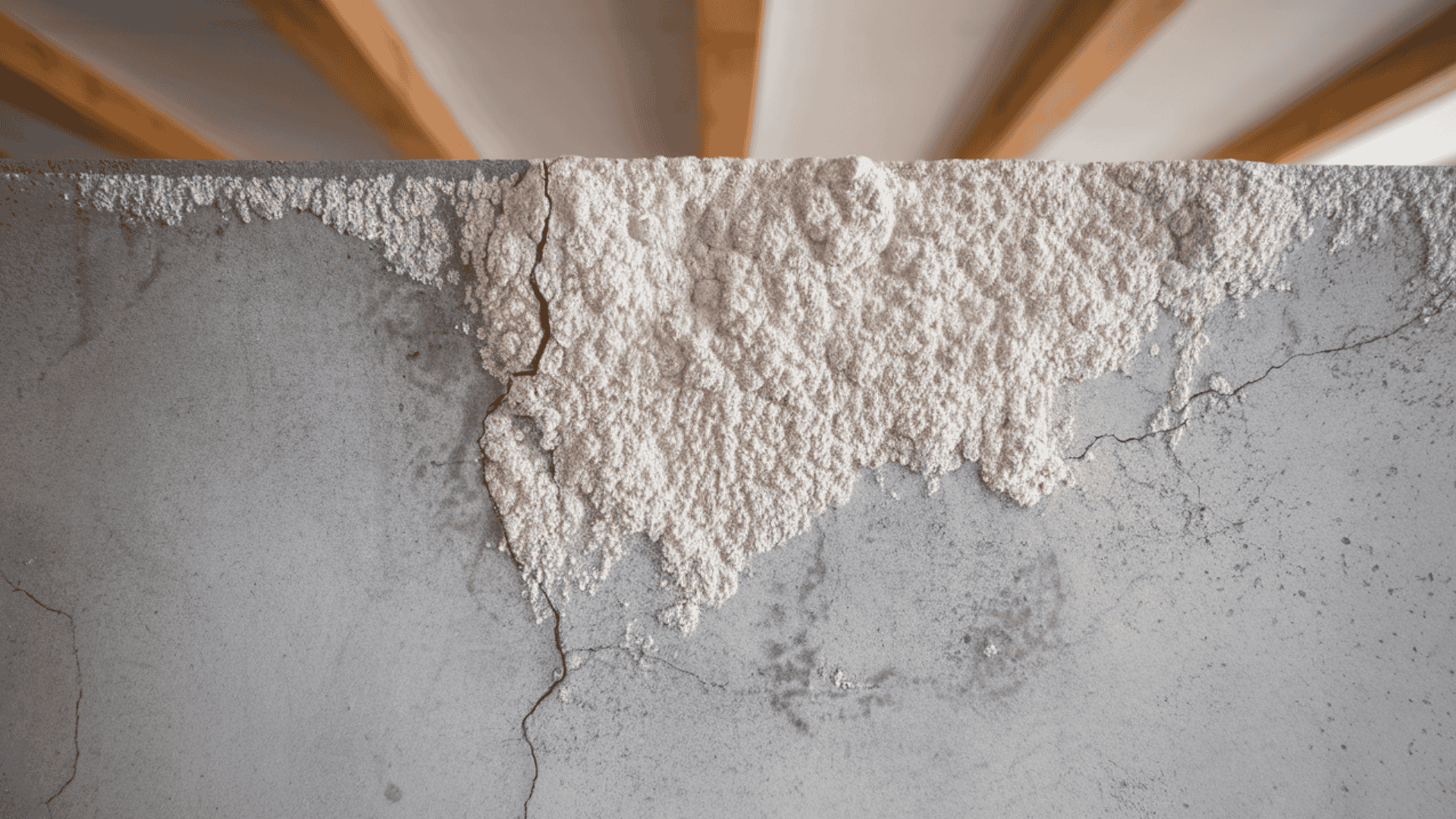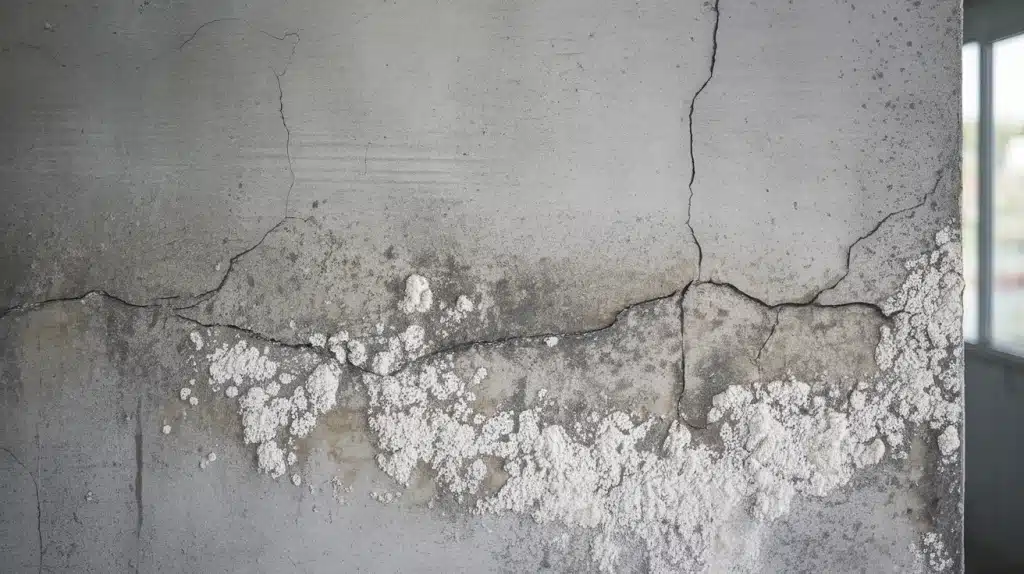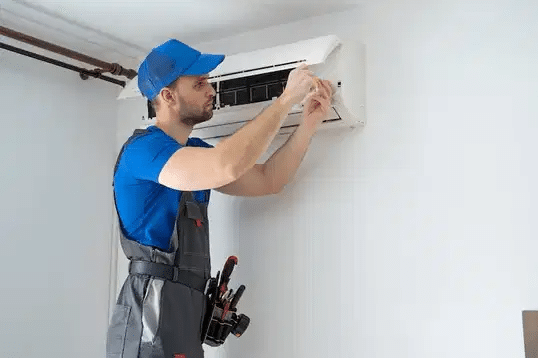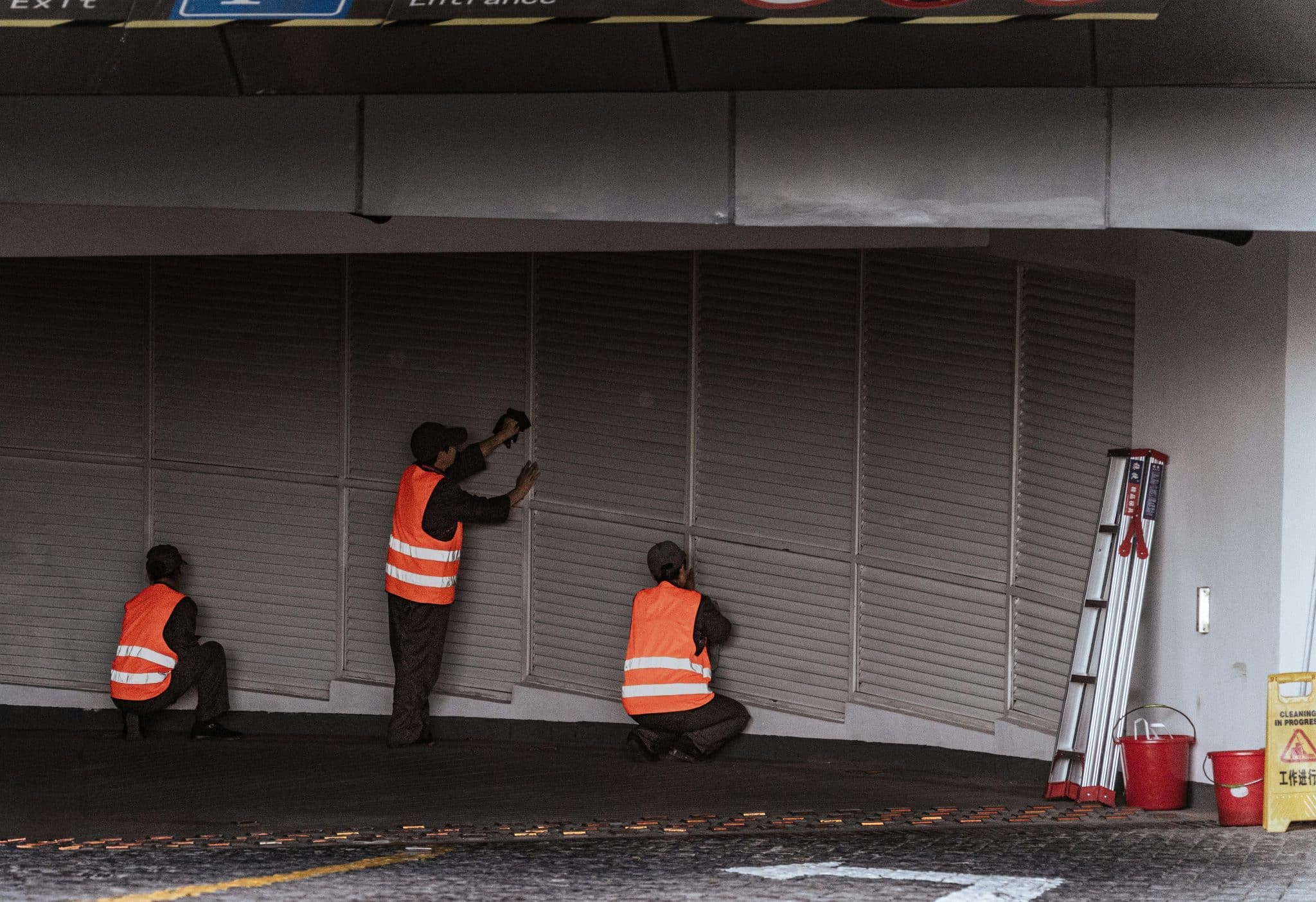You walk into your basement and spot something that wasn’t there before: white, chalky streaks covering your concrete walls like someone threw flour around.
Your heart sinks. Is it mold? Structural damage? Something expensive to fix? Take a deep breath. What you’re seeing is likely efflorescence, and while it’s frustrating, it’s not the end of the world.
This white powder is your basement’s way of alerting you to moisture problems that require attention. The good news? You can usually fix this yourself.
This guide will explain what efflorescence is, why it occurs, how to remove it safely, and most importantly, how to prevent it from returning, allowing you to enjoy a dry, clean basement again.
What Is Concrete Efflorescence?
Concrete efflorescence is a white, chalky powder that appears on concrete walls, floors, and brick surfaces when water moves through the material and leaves behind salt deposits.
You’ll spot it as crusty, white streaks or patches that resemble someone sprinkling flour on your basement walls.
This occurs when water carries salts from within the concrete to the surface, where they evaporate, leaving mineral deposits behind.
While efflorescence itself isn’t mold, it signals moisture problems that can create perfect conditions for mold growth later.
It commonly appears on basement walls, concrete floors, brick foundations, and any other masonry surface where water and salts meet.
What Causes Efflorescence in Concrete?
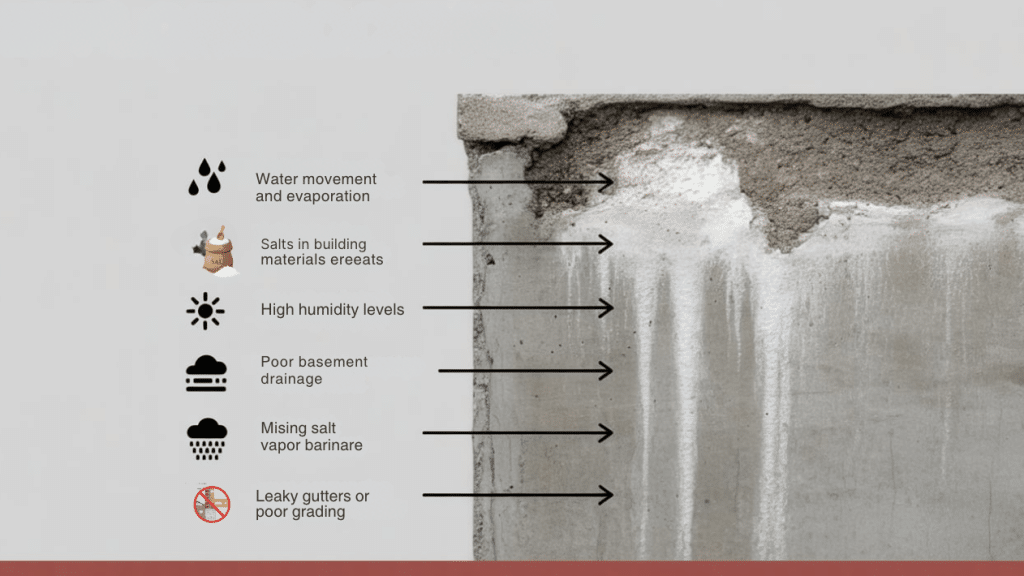
The leading cause is straightforward: when water combines with salts, it results in white deposits. Here’s what creates this frustrating problem:
Primary Causes:
- Water movement and evaporation – Water soaks into concrete, picks up salts, then evaporates at the surface
- Salts in building materials – Concrete, mortar, and soil naturally contain mineral salts
- Poor basement drainage – Water finds ways into your basement through cracks and weak spots
Key Triggers That Make It Worse:
- High humidity levels – Keeps moisture moving through concrete walls
- Temperature changes – Hot and cold cycles push water in and out of the concrete
- Groundwater seepage – Underground water pressure forces moisture through foundation walls
- Missing vapor barriers – No protection between the soil moisture and the concrete surfaces
- Leaky gutters or poor grading – Water pools around your foundation instead of flowing away
Is Efflorescence Dangerous?
Efflorescence itself won’t harm you or damage your concrete structure, but it’s like a warning light on your car’s dashboard; ignoring it will lead to bigger problems.
While the white deposits are primarily a visual annoyance, leaving them untreated opens the door to serious issues, including mold growth in damp conditions, peeling paint, damaged wall finishes, and ongoing water problems that could weaken your foundation over time.
Think of efflorescence as your basement’s way of telling you that moisture is getting where it shouldn’t be, and that underlying water intrusion needs your attention before it turns into costly repairs.
How to Identify Efflorescence in Your Basement
Efflorescence appears as a white, powdery residue on concrete surfaces. It’s a clear sign that moisture is moving through your basement walls or floors.
Quick Visual Check:
| What to Look For | Where You’ll Find It | What It Looks Like |
|---|---|---|
| White/chalky residue | Concrete walls, floors, and joints | Powdery white streaks or patches that brush off easily |
| Dampness or discoloration | Wall surfaces, corners | Dark spots, wet patches, or stained areas around white deposits |
| Paint peeling or bubbling | Painted basement walls | Paint that lifts, cracks, or forms bubbles near white areas |
DIY Test to Confirm It’s Efflorescence (Not Mold):
| Step | What to Do | Result |
|---|---|---|
| 1. Water Test | Spray plain water on the white deposit | Efflorescence: Dissolves and disappears Mold: Stays put |
| 2. Vinegar Test | Apply white vinegar to the remaining residue | Efflorescence: Fizzes and bubbles (acid reaction) Mold: No reaction |
| 3. Brush Test | Gently brush the area when dry | Efflorescence: Comes off as powder Mold: Smears or stays attached |
Removing Efflorescence: Step-by-Step
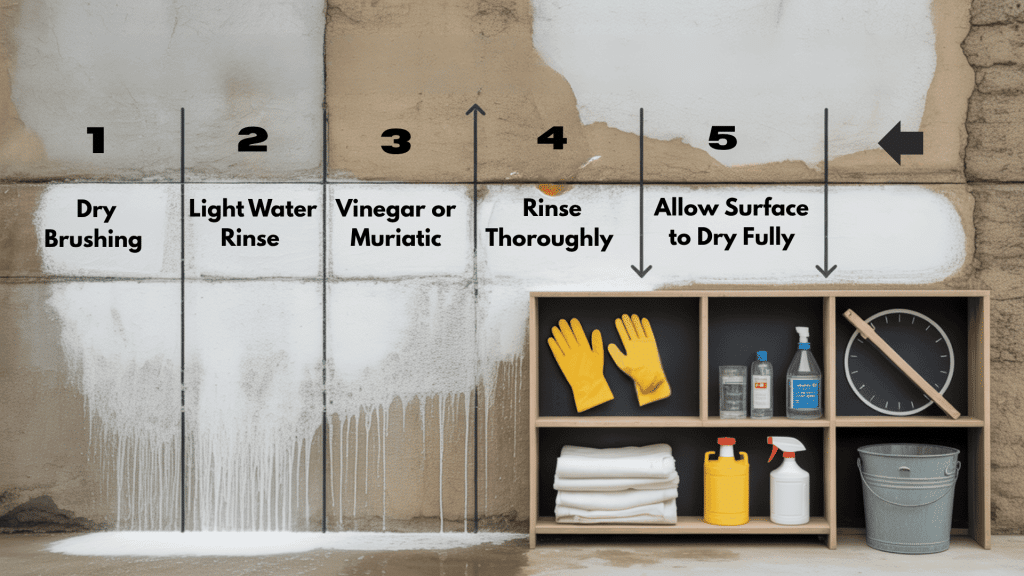
Removing efflorescence is straightforward with the right tools and a few careful steps. Here’s how to do it safely and effectively.
Tools and Materials You’ll Need:
- Stiff-bristled brush – For scrubbing off loose deposits
- White vinegar or muriatic acid – Cleaning solutions to dissolve salt residue
- Protective gear – Safety gloves and glasses are essential
- Clean water – For rinsing away acid and dissolved salts
- Old rags and spray bottle – For applying solutions and cleanup
- Good ventilation – Open windows or fans for safe air circulation
Step 1: Dry Brushing
Start by scrubbing the white deposits with a stiff brush while the surface is completely dry. This removes most of the loose salt crystals without spreading them around with water. Work in circular motions and brush debris into a dustpan for easy cleanup.
Step 2: Light Water Rinse
Spray or wipe the area with clean water to dissolve remaining salt residue. Use just enough water to dampen the surface – too much water can push salts deeper into the concrete. Let the water sit for 2-3 minutes to break down stubborn deposits.
Step 3: Vinegar or Muriatic Acid Solution (With Caution)
Apply white vinegar for mild cases, or diluted muriatic acid (1 part acid to 10 parts water) for tough stains. Always add acid to water, never water to acid, to prevent dangerous splashing. Let the solution sit for 5-10 minutes, allowing it to fizz and break down the mineral deposits.
Step 4: Rinse Thoroughly
Flush the entire area with clean water to remove all acid residue and dissolved salts. Use plenty of water – leftover acid can damage concrete over time and create new problems. Pay extra attention to corners and cracks where the solution might pool.
Step 5: Allow Surface to Dry Fully
Let the concrete air dry completely for 24-48 hours before applying any sealers or coatings. Good ventilation speeds up drying and prevents new moisture problems. Check that the surface feels completely dry to the touch before moving to the next step.
How to Prevent Efflorescence in Basements
- Improve basement ventilation and reduce humidity by running a dehumidifier and installing exhaust fans to maintain moisture levels below 50%.
- Seal concrete surfaces with breathable sealers – Apply penetrating sealers that block water but let trapped moisture escape naturally.
- Address drainage issues by cleaning gutters, grading the soil away from your foundation, and installing sump pumps as needed.
- Install vapor barriers or waterproof membranes – Place plastic sheeting between the soil and concrete to prevent ground moisture from migrating through the walls.
- Avoid using salt-heavy construction materials- Choose low-sodium concrete mixes and mortars when doing repairs or new construction work.
When to Call a Professional?
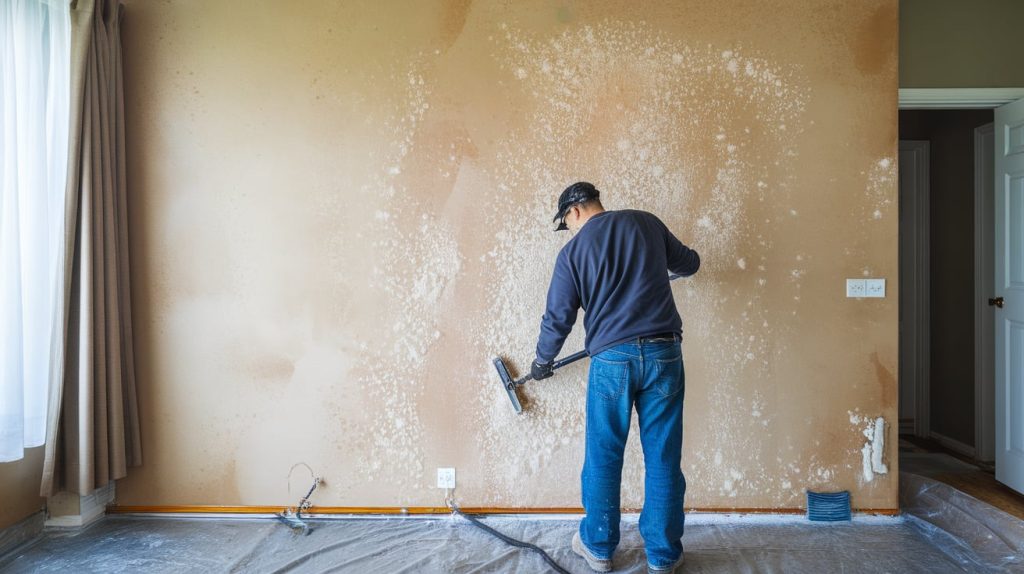
Call a professional when efflorescence keeps recurring after cleaning, when you notice foundation cracks or ongoing water seepage that suggests deeper structural issues, or when you smell musty odors that indicate mold growth and indoor air quality problems.
If your DIY efforts aren’t working and the white deposits return within weeks, or if you’re seeing water damage that extends beyond surface stains, it’s time to seek expert help.
A basement waterproofing specialist can identify the root cause of moisture problems and fix them properly, saving you from repeated cleaning cycles and potential health risks.
Conclusion
Concrete efflorescence might look scary when you first spot those white streaks on your basement walls, but now you know it’s completely manageable.
Remember the key steps: identify it correctly using simple tests, clean it safely with basic tools, and most importantly, fix the moisture source to prevent it from returning.
Whether that means improving ventilation, sealing surfaces, or fixing drainage issues, taking action now saves you bigger headaches later.
Regular basement inspections help you catch problems early before they become expensive repairs. If the white deposits continue to appear despite your best efforts, don’t hesitate to call a professional.
Ready for a refresh? Explore more home improvement ideas to upgrade your space.
Frequently Asked Questions
How Do You Fix Efflorescence in Concrete?
Brush off the white deposits, clean with a vinegar or mild acid solution, rinse thoroughly, and then address the underlying moisture problem to prevent it from returning.
Should I Remove Concrete Efflorescence?
Yes, Remove It Promptly Because While the Deposits Themselves Are Harmless, They Signal Moisture Problems that Can Lead to Mold Growth and Structural Damage.
Does Vinegar Remove Efflorescence from Concrete?
Yes, White Vinegar Effectively Dissolves Efflorescence Deposits Through Its Mild Acid Content, Making It a safe DIY cleaning solution for Most Cases.
Should I Be Worried About Efflorescence?
Don’t panic, but take it seriously – efflorescence itself won’t harm you, but it’s a warning sign of moisture issues that need attention before they cause more significant problems.

